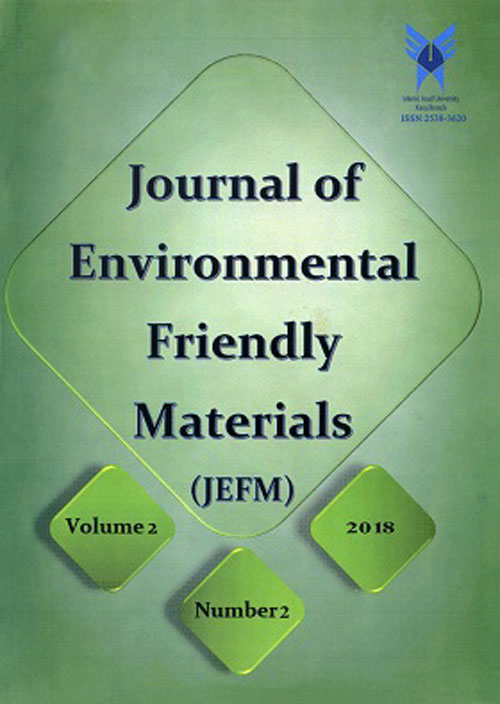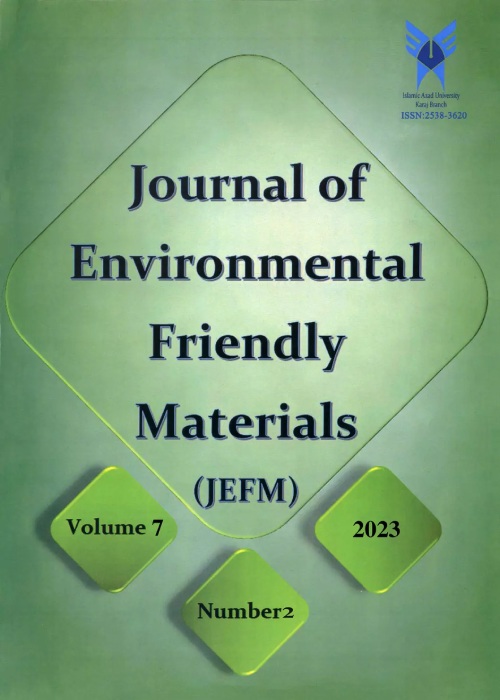فهرست مطالب

Journal of Environmental Friendly Materials
Volume:3 Issue: 1, Winter-Spring 2019
- تاریخ انتشار: 1397/12/24
- تعداد عناوین: 8
-
Pages 1-7The application of hardfacing materials for producing wear-resistant coatings on components working in wear conditions is one of the important advices in environmental protection and increasing the service life of engineering equipment. In this study, the microstructure of the hardfaced layers made by two cored wires containing Fe-B and Fe-B-C powder-based were investigated. ST37 plain carbon steel was used as the substrate and the deposition of the hardfaced layers was conducted by the flux cored arc welding (FCAW) process under single-, two-, and three-pass conditions. The microstructural and phase analyses were carried out by field emission scanning electron microscopy (FE-SEM) and X-ray diffraction (XRD), respectively. The results showed that the characteristic microstructures of the Fe-B hardfacing alloy layers comprised a matrix containing elliptical dendritic ferrite and the eutectic of (α-Fe2B). But, the Fe-B-C hardfacing alloy layers included columnar-like Fe2B, skeletal-like Fe2B, daisy like Fe3(C, B) and the eutectic of (P-Fe2B).Keywords: Hardfacing, Microstructure, Fe-B, Fe-B-C, FCAW
-
Pages 9-16In this research, ultrahigh strength transformation induced plasticity-assisted steel (TRIP-assisted steel) was developed to be used in the automobile body. For this, it is essential to characterize its weldability in resistance spot welding process. Therefore, the resistance spot welding metallurgy and weldability of the steel under different welding parameters are studied. the desired sample was studied in two states with higher pressure and less time. The results are presented following the most important advantage of the current steel in contrast to the similar steels is its excellent weldability enabling its application in the auto pillar. The microstructure and mechanical properties of TRIP steel spot welds were characterized using metallurgical techniques, lap shear tensile tests fractography and microhardness testing methods. Failure mode transition from interfacial to pullout failure mode was achieved for sample 10kA with 4kN. Partial interfacial failure was removed after nugget size increased. Pullout failure mode is seen for the sample 2, 10kA with 3.5kN.Keywords: TRIP Steel, Resistance Spot Welding, mechanical properties, Failure Mode
-
Pages 17-22In the present study, IN718 super alloy was produced by selective laser melting (SLM) method and was imposed under solution heat treatment at temperature of 1040°C for 2 hours. Three different environments, such as water, air and furnaces were used to cool the samples after complete solution. The results of microstructural studies conducted by optical microscopy (OM) and field emission scanning electron microscopy (FESEM) showed that intermetallic precipitates were formed during the process, disappear after solution. In order to complete the FESEM results, X-Ray diffraction (XRD) test showed that in at all cooling rates, the only remaining phases of matrix are the austenite (γ) and carbides, which their locations are between the grains according to the microscopic images. This issue indicates the proper selection of solution parameters and proper execution of solution process. The micro hardness test showed that doing solution treatment to reduce the volume fraction or completely remove the secondary phase leads to decreased hardness. By increasing cooling rate, the hardness of samples was reduced, so that the hardness of sample chilled in 30 % water was reduced compared to the sample before the heat treatment.Keywords: IN718 Superalloy, Selective Laser Melting (SLM), Solution Heat Treatment, Microstructure, Hardness
-
Pages 23-27The effect of aging process on hardness as well as the superelastic behavior of NiTi shape memory alloy with 58.5 wt. % Ni has been investigated in this paper. The aging process has been performed at different temperatures ranging from 400 oC to 800oC and for various exposure times from 30 min to 8 hours. The results showed an increase in hardness in the temperature range from 400 oC to 500 oC and then a decrease occurs. At constant temperature with prolonged aging time a gradual increase of hardness occurs. SEM observations showed that there is some precipitation in specimens aged from 600 oC to 800 oC. The decrease of hardness can be due to an increase in precipitate size. The superelastisity investigation at 25 and 60 oC showed that the maximum superelastisit results are related to specimens aged at 400 oC. The superelastisity properties of NiTi were discussed in terms of hardness and microstructure.Keywords: Shape Memory Alloy, Nitinol, heat treatment, Superelasticity, Structural Properties
-
Pages 29-38Brake system and its components are of high importance in rail transportation systems. In this regard, brake linings, pads and blocks are especially important and this is why periodic evaluation of these parts is common practice in all rail systems. In this paper, some characteristics of three types of brake pads (friction materials in disc type brake mechanism) named types A, B and C (not to reveal the brand types) used in Iranian railways are compared against each other. Type A is an European product and the other two are Iranian pads manufactured domestically at different stages (type B is a new product and type C is an old one). The surface of pads, its compound, density, porosity, water adsorption, and impact strength and friction coefficient are evaluated. By comparing the results, it is appeared that the European brake pad possessed the lowest porosity, the highest impact strength and variation of its friction coefficient was more stable than the others. In addition, the performance of the type C compared with type B seemed to be much better in regard to wear rate and impact strength.Keywords: Rail Brake, Friction Lining, Rail Safety, Brake Pads, Iranian Railways Industries, Wear
-
Pages 39-43Joint of dissimilar steels is widely used in the chemical, food, oil, water and sewage industries. In the meantime, the joint of carbon steels to austenitic stainless steels is important with the GTAW welding process. In this paper, weldability of 304 stainless steel to CK45 carbon steel by GTAW method according to the filler metal parameter has been investigated. Welding of the samples was performed via gas tungstenarc welding (GTAW)method using 3 types of ER308L, ER310, and ER316L metal filler. Tensile test was done to evaluate the joint weldability. The microstructure of the samples was also studied using OM and FE-SEM microscopes. In the tensile test, the welded sample with ER308L electrode was fractured from HAZ area close to Ck45 base metal. Microstructure investigations showed that the best structural quality in this joint is the achievement of the stable austenite with a low amount of ferrite when using ER308L metal filler, and the worst structure was related to the use of ER310L metal filler that completely austenite structure with crack in the weld metal area was created. The results of tensile test showed that the maximum yield strength and tensile strength is achieved 382 MPa and 675 MPa using ER308L metal filler, respectively.Keywords: Welding of Dissimilar Steels, 304 Stainless Steel, Ck45 Carbon Steel, GTAW
-
Pages 45-48The existence of various industries such as energy, propulsion, construction, machinery, military and power plants have led Iran to become one of the major users of weld science and technology and other joining methods in the Middle East. The economic significance of welding is to a degree that more than 50% of the gross industrial product of the various countries and 42% of the Iran economy are said to be related to welding. The quality of the inspection services will be effective in increase the safety of the structures and reduce the impact of disasters and costs. The goal of this study is to identify the effective components in the quality of the welding inspection and ultimately provide the possibility of improving the performance of welding inspection companies in the country. This study is carried out as a descriptive and sectional study from employers of a technical inspection company using a 25-items questionnaire with standardized 5-point Likert scale and adjusted SERVQUAL in six dimensions of competence, reliability, accountability, service guarantee, security / secrecy and independence/ Impartiality. Data analysis was done by t-paired test using SPSS software. Based on the quality of the welding inspection services, the security / secrecy dimension has the highest gap and independence has the lowest gap and competence dimension has the highest quality. According to the importance –performance analysis, the dimensions of responsiveness power and guarantee of the evaluated services of company are located in the first area of importance-performance matrix. The results can be effective in assessing the competitive position of the organization and identifying opportunities for improving the inspection companies.Keywords: Quality, SERVQUAL Model, Importance-Performance Analysis
-
Pages 49-53As concerns about population growth, global warming, resource scarcity, globalization, and environmental degradation have increased, it has become apparent that engineering materials design must be engaged more effectively to advance the goal of sustainability. This will require a new develop materials that incorporates sustainability factors as explicit performance criteria. Sustainable development is integrity of multi discipline concept combining, environment, and ecological, social and economic aspects to construct a livable human living system. The sustainable development can be support through the development of green engineering materials. Green engineering materials offers a unique characteristic and properties including abundant in nature, less toxic, economically affordable and versatility in term of physical and chemical properties. Green engineering materials as metallic materials. Polymer materials, concert materials and etc, can be applied for a numerous field in science and technology applications including for energy, building, automotive, aircraft, urbanism, maritime industries, construction and infrastructures.Keywords: Green Engineering Materials, Metallic Materials, Polymer Materials, Concert Materials


